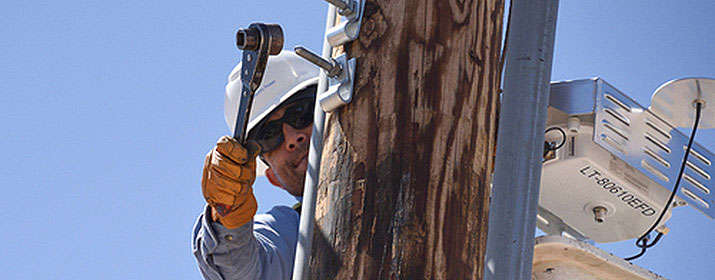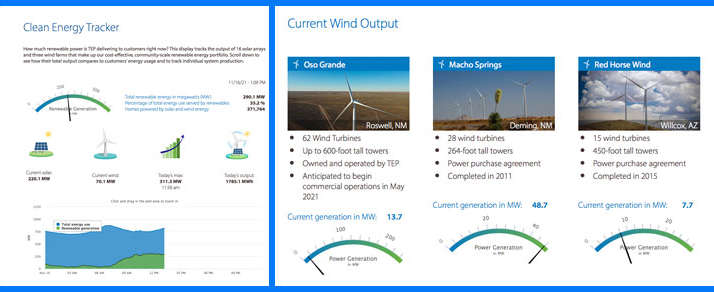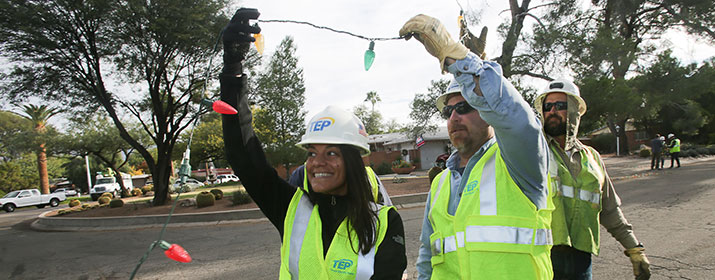
Maintaining all the equipment in our local grid – which spans 1,155 square miles – is an enormous undertaking.
Tucson Electric Power’s electrical system is an intricate network of power lines, substations, circuits and utility poles. Since 2018, we have invested nearly $1.8 billion and thousands of hours to maintain the integrity of our system and keep equipment in top working order.
“Over the past 120 years, our local electric grid has greatly expanded and become increasingly more complex,” said Terry Nay, TEP’s Vice President of Field Operations. “All of our 316 field operations employees are focused on the challenging task of testing, maintaining, upgrading and expanding this equipment that’s essential to powering our lives.”
Here’s what we do to maintain the major components of our electrical system to ensure the safe, reliable delivery of energy to homes and businesses.
Keeping the Power Flowing
Transmission lines and towers carry higher voltage electricity from generating stations across many miles into communities. They’re critical to maintain because any fault could cause a widespread outage.
If you strung out all our overhead 500, 345 and 138-kilovolt (kV) transmission lines supported by 5,500 towers, the length would equal about the same distance from Tucson to Manhattan: 2,200 miles.
“Because our lines are so expansive over many miles, we inspect 20 percent of our 345kV lines and 100 percent of the 138 and 500 kV lines each year with the entire length of our transmission lines completed in five years,” said Ernesto Ojeda, TEP Director of Equipment & Asset Management.
TEP conducts annual ground patrols as well as aerial inspections by helicopter each spring and fall to check the condition of lines, towers, anchors and guidelines. Our inspectors also look for signs of sabotage and vegetation encroachment.
“Anything needing repair is assigned a priority level with highest priority items addressed immediately. Other priority issues are addressed within 10 days,” said David Wagner, TEP Director of Transmission & Distribution Line Construction and Metering. “Less critical items are sent to our maintenance planner so that they can be added to the schedule and are grouped by geographical area for efficiency.”
As a proactive measure, TEP has been systematically replacing older 138kV wood structures with steel poles since 2012 to harden our transmission system.
Tending to Substations
TEP’s 121 substations – which house transformers, switches and circuit breakers – serve as an important link between our transmission and distribution systems. Substation transformers “step down” high voltage electricity from transmission lines to lower voltages for distribution through circuits into neighborhoods. Each substation transformer – which can take up to two years to procure and costs $1.4 million – serves about 2,000 customers.
“We rate the condition of each transformer every year with a health index number to determine if it is degrading,” explained Ojeda. “We look at the oil condition, its maintenance and reliability history, age and other factors. This allows engineers to estimate its remaining life and plan a maintenance and replacement schedule.”
The condition of the oil in the transformers also is monitored and tested regularly by crews. Some of our transformers have an online monitor that samples the oil and sends an alert to system control if it detects gas buildup.
In addition to our installed substations, TEP maintains mobile substations and transformers for use during extended outages, times of high energy usage or when we’re making upgrades and improvements to equipment.
Maintenance for our most critical substation circuit breakers is scheduled based on the manufacturers’ recommendations or as needed based on the results of diagnostic tests. “All our newer substations use telemetry to remotely monitor and detect faults and provide an alarm to help pinpoint problems,” Ojeda said.
If a circuit breaker needs maintenance or to be replaced, TEP uses spares while the breakers are replaced, relubricated or refurbished. As a proactive measure in 2011, TEP accelerated the replacement of older breakers to harden our system.
Checking Distribution Lines and Cables
TEP’s distribution system consists of more than 3,000 miles of overhead lines and 4,700 miles of underground cables that carry lower voltage electricity from our substations through circuits to customers. Crews visually inspect the condition of the lines, crossarms and pad-mounted equipment on a three-year cycle.
Engineers also perform an annual critical circuit analysis to evaluate our 438 circuits for their reliability based on outage data, demand, capacity, age and load. Some 300 remote sensors installed in our system also detect power interruptions in real-time to identify faults so that repairs and upgrades can be scheduled.
While underground and feeder cables require less maintenance, crews inspect them when they have the opportunity and are working on them. They use a very low frequency test to gather information about the insulation quality and remaining cable life. This test along with statistical analysis based on the cable’s age and environmental issues are used to assess cables, identify any potential problems and proactively make repairs.
“In addition to all our regular maintenance, there’s a lot of proactive work being done by our engineers to reinforce the integrity of our system,” Wagner said. “They are constantly identifying heavier loads to circuits that are driven by hotter summers, new growth and development. As they reach their capacity, we may need to add a new substation or upgrade our system.”
Testing and Replacing Poles
More than 110,000 utility poles – some of which are as old as middle-aged saguaros – dot the landscape of our service area. Even though some of our poles were installed decades ago, they remain useful if they’re solid, sturdy and dependable. In 2020, TEP accelerated our pole testing and replacement program to focus on the greatest number of older poles.
To test the strength of our poles, crews perform a resistance test. This involves drilling three small holes in specific locations of the pole to assess its structural integrity and identify signs of rot or decay. Our engineers use the results from the test to determine which poles need replacement.
“All of the distribution system poles and pad-mounted equipment are visually inspected or tested every three years,” said Wagner. “We conduct a detailed wood pole inspection that includes resistance testing to pick which poles are next to be replaced for our pole replacement program,” Wagner said. “We are trying to convert wood poles to steel, but in some areas where bucket trucks have poor access, we use wood poles so crews can safely climb them to make repairs.”
Carlet Castro, Manager of Transmission & Distribution, said TEP replaces about 1,200 poles a year, due to storm or vehicle damage, routine maintenance, system upgrades and line relocations. “This does not include new pole installations driven by new system reinforcement and business development,” she said.
Trimming Back Vegetation
Finally, a big part of maintaining our system involves vegetation management. Trees and vegetation that encroach on our lines or equipment must be trimmed back to ensure service reliability.
To provide a wide clearance for our transmission lines, employees inspect and monitor vegetation growth by ground and air. Vegetation is trimmed based on a five-year growth cycle to comply with mandatory North American Electric Reliability standards. Keeping our transmission lines free of interference from vegetation helps reduce potential fuel sources for wildfires and prevent power outages.
We also continuously monitor 120,000 trees in public rights-of-way and trim 20,000 a year to cover our entire service area over six years. Using mobile technology, we track historical vegetation growth patterns to identify areas of faster growth that might need more frequent trimming. Our tree trimming crews also are on standby for emergencies if downed branches or trees must be removed to help us restore power sooner.
“We expend enormous resources and effort into maintaining and enhancing our grid because we know our customers count on us,” said Nay. “We are honored and proud of our employee’s dedication to ensuring reliable service to the greater Tucson community.”






